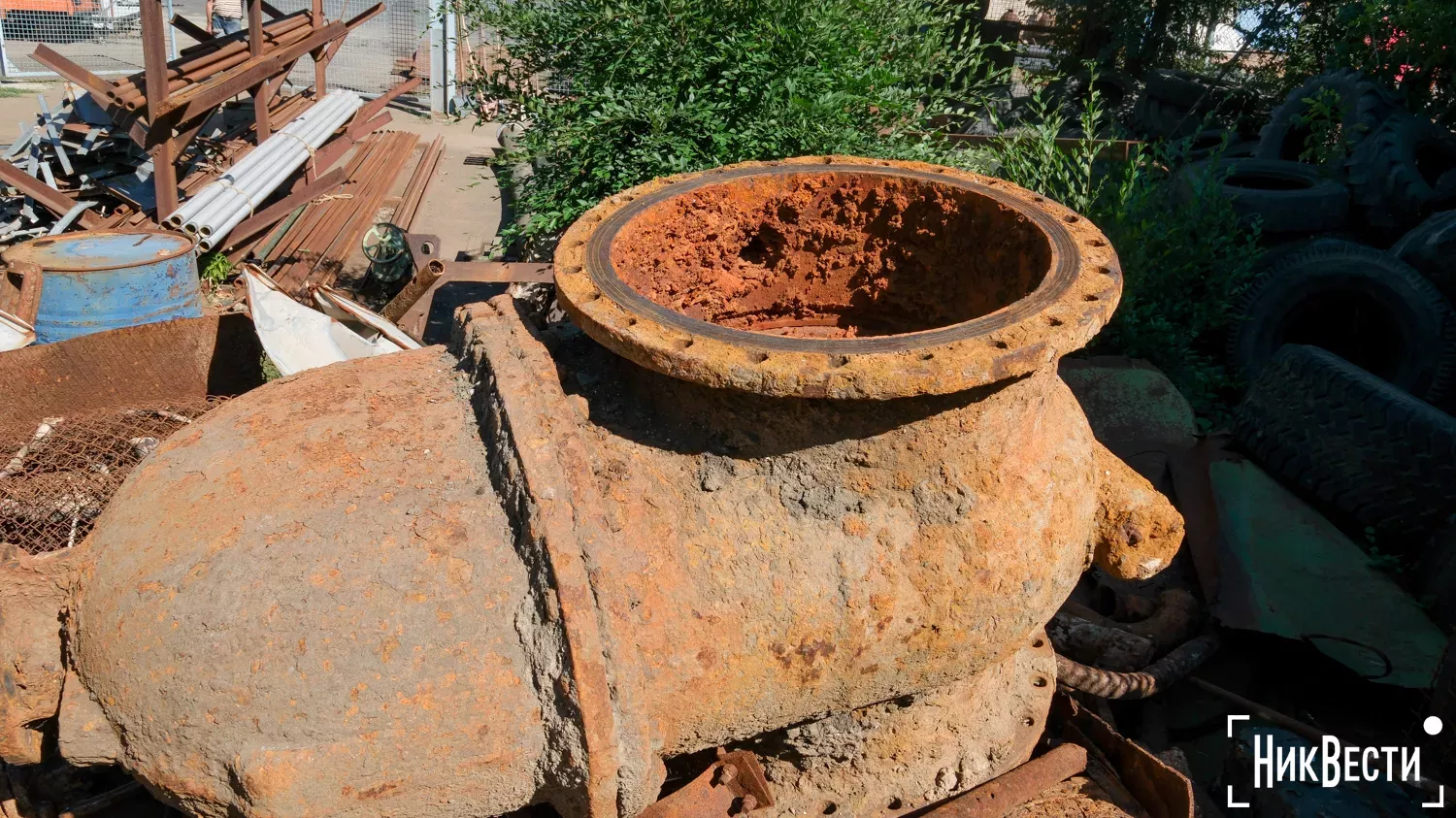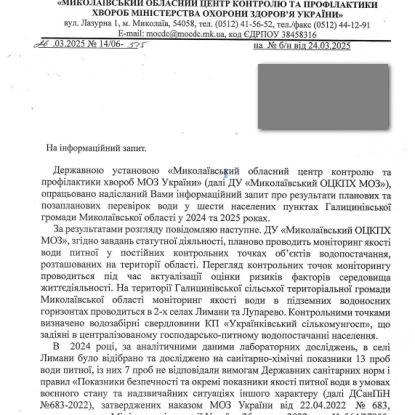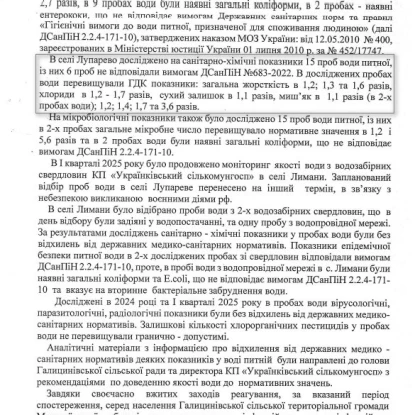Arsenic and harmful bacteria found in water samples in Halytsynove community of Mykolaiv region for two years in a row
- Alona Kokhanchuk
-
•
-
14:23, 07 April, 2025
 A view of the mouth of the Pivdennyi Buh River, near the village of Lupareve in Mykolaiv region. Photo by Ukrainer
A view of the mouth of the Pivdennyi Buh River, near the village of Lupareve in Mykolaiv region. Photo by UkrainerIn 2023 and 2024, arsenic was detected in water samples from wells and the water supply network in the Halytsynove community of Mykolaiv region. However, no one knows how it got into the water.
This is described in the article NikVesti: «Drinking Trouble: Why Tap Water in Mykolaiv Region Poses a Risk».
In September 2023, the State Service of Ukraine for Food Safety and Consumer Protection detected arsenic in the water of the Halytsynove community. After that, in November, experts from the Mykolaiv Regional Centre for Disease Control and Prevention of the Ministry of Health took 13 water samples twice. According to the results of the research in the village of Lymani, two out of five water samples contained arsenic concentrations that exceeded the maximum permissible concentration (MPC) by 1.1 and 1.2 times. Also, two water samples did not meet the standards for microbiological indicators.
In the village of Lupareve, arsenic exceeded the MPC by 1.7, 2.8 and 3.4 times in 3 samples out of 8 tested, and in 4 samples. In addition, all 8 water samples examined did not meet the standards for microbiological indicators.
Arsenic was also detected in water from the Halytsynove community in 2024. According to the Mykolaiv Regional Centre for Disease Control and Prevention of the Ministry of Health, the maximum permissible levels of arsenic in different water samples from the village of Lupareve exceeded the maximum permissible levels by 1.1 to 3.6 times.
Ivanna Zvonik, chief engineer of the utility company «Ukrayinkivskyi Selkomunkhoz», said that arsenic is currently not present in the community's water.
«"We have not yet carried out departmental control of wells. We are planning to do it in April. The regional sanitary and epidemiological station (Mykolaiv Regional Centre for Disease Control and Prevention of the Ministry of Health, — note) They have to provide us with the results. They checked the Limans. Over the phone, they told us that only the water in the grocery store was bad, as usual after winter, and that arsenic was not found. But these are just words, I can't confirm them with a document yet. We will continue to analyse the water», she says.
At the request of NikVesti, the Mykolaiv Regional Centre for Disease Control and Prevention of the Ministry of Health provided the results of a water analysis conducted in 2025. In the village of Lymany, water samples were taken from two water intake wells and one sample from the water supply network. Arsenic was not found in the water, but the water from the water supply network does not meet sanitary requirements, with coliforms (bacteria that are an indicator of faecal or other organic contamination) and E. coli (bacteria that originate from faecal contamination, most often from sewage or manure).
It is worth noting that there are currently no analysis results from the village of Lupareve, and it is not known whether arsenic is still present there. In addition, the community does not know how arsenic got into the water and whether it will return again, as no studies have been conducted.
«There have been no studies of this kind. These studies should be conducted by specialised laboratories, specialised bodies.... We cannot say what influenced this. We are not an organisation that can conduct research. We carry out departmental control in laboratories that we like or not, but we have to trust», adds Ivanna Zvonik.
We would like to add that due to the development of the industry, the WHO has classified arsenic as one of the 10 most dangerous chemical elements. The maximum permissible concentration for drinking water is set at 0.01 mg/l (10 µg/l). Scientists have proven that arsenic is a carcinogen that can cause cancer, leukaemia and organ damage. It also harms the skin by causing pigmentation, which can appear after a year of drinking water with a concentration of more than 0.4 mg/l.
As a reminder, work has begun in Mykolaiv region on the construction of a new water supply system that will provide Mykolaiv residents with drinking water after almost three years of its absence.
Water supply for Mykolaiv
Almost three years have passed since Russian troops damaged the water supply pipeline that supplied Mykolaiv with water. Since then, the city of almost half a million people been a centralised supply of drinking water. Currently, Mykolaiv residents receive water from a backup source, which raises many questions about the quality of the water and the salt content.
The salt water damaged 1,200 kilometres of the city's water supply network. Boris Dudenko, director of «Mykolaivvodokanal», said that it is impossible to replace the entire length of the network that was damaged by salt water. As of August 2024, only about 3 kilometres of the network had been replaced.
 Saltwater-damaged pipes stored at the company «Mykolaivvodokanal», August 2024, photo «NikVesti».
Saltwater-damaged pipes stored at the company «Mykolaivvodokanal», August 2024, photo «NikVesti».
All this time, representatives of state and local authorities were looking for options to restore drinking water supply in Mykolaiv. The final solution was found in 2024: a new water supply system will be laid from Nova Odesa, and the money was allocated from the state budget.
The Regional Reconstruction Service has already selected contractors who will work according to the principle of «design-build». They are three companies, each of which is responsible for one of the three work areas: «Ukrtransmist», «Rostdorstroi» and «Motorway».
The future water supply system for Mykolaiv is expected to be built and launched by autumn 2025, said Serhii Sukhomlyn, head of the State Agency for Reconstruction.
However, the question of the new water supply system's design capacity remains unresolved: on the one hand, there is an opinion that water consumption in Mykolaiv has decreased, and therefore a new calculation needs to be made, and on the other hand, limiting the amount of water can directly affect the future development of the city and its industry.
Back during the conference in Berlin in 224, the First Deputy Speaker of the Verkhovna Rada, Oleksandr Korniienko, answering a question NikVesti, said that the lack of drinking water in Mykolaiv was one of the biggest problems in Ukraine that the state should solve in the near future.
And President Volodymyr Zelenskyy has ordered the construction of a new water supply system to provide Mykolaiv with drinking water «under the fast track option» - drinking water should be available by the summer of 2025. The government has already approved the relevant programme.

